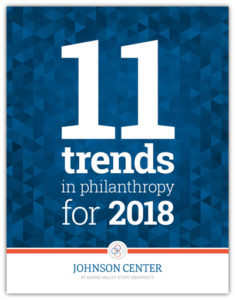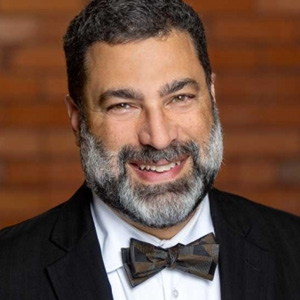Governments and Nonprofits: New Partnerships or Paradigm Shifts?


Download and read the full report, featuring all 11 trends, here.
 As priorities of government have shifted away from directly providing services and programs, there has also been an explicit and implied expectations shift between government and philanthropy (defined here to include donors, volunteers, charities, and foundations). The partnerships between governments and philanthropy have evolved from working on similar issues independently, to working together or in place of one another. Consequently, there are new challenges in terms of roles, responsibilities, resources, and repercussions that merit exploration.
As priorities of government have shifted away from directly providing services and programs, there has also been an explicit and implied expectations shift between government and philanthropy (defined here to include donors, volunteers, charities, and foundations). The partnerships between governments and philanthropy have evolved from working on similar issues independently, to working together or in place of one another. Consequently, there are new challenges in terms of roles, responsibilities, resources, and repercussions that merit exploration.
In recent years, philanthropy has undeniably taken on a larger role in meeting community needs and serving as an economic engine. Nearly one-third of nonprofit sector revenues come from public sources to fund vital services (McKeever, 2015). And one in ten workers in America are employed by a nonprofit organization. That workforce is growing in response to society’s demands (Bureau of Labor Statistics, 2016).
What is more fascinating (and perhaps alarming), is the many ways, in which philanthropy is now temporarily substituting for, or flat out supplanting, the traditional roles of government. A few examples from Michigan present very different, yet similarly complicated examples of sector role conflation.
Kalamazoo, Mich. launched the Kalamazoo Promise — an effort to provide higher education opportunities for all public-school graduates — with the support of five anonymous donors (Bartik, 2015). In that same community, two other donors have committed their wealth toward the creation of a new nonprofit, the Foundation for Excellence, which provides funds to maintain a stable property tax rate and structure and funds innovative community solutions as defined by city government.
Flint, Mich. experienced one of the nation’s greatest infrastructure failures when the city switched its public water source to the Flint River without proper anticorrosion treatment, thereby damaging the plumbing system, and leaching lead into the drinking water (Bosman, 2016). Foundations and nonprofits stepped up as first responders, delivering bottled water and water filters to residents. A group of foundations ultimately stepped in to underwrite the costs of switching the water back to the original source, and the community foundation launched a response fund to provide for the long-term nutrition and education needs of the children affected by the increased lead levels (French, 2016).
When Detroit, Mich. filed for bankruptcy in July 2013, its debt was estimated at $18-$20 billion. Several foundations pooled their resources to help ensure that pensioners could survive on their fixed incomes, while the Detroit Institute of Arts (which was otherwise headed for the auction block) was reinvented as a nonprofit with a solid financial footing. A new fund was developed through the local community foundation to disperse settlement funds to various individuals and organizations involved in the settlement. (Ferris, 2017)
If paradigm shifts such as these are a good thing for the sector and demonstrate the versatility and leadership philanthropy can demonstrate, there are important questions to address as these new “muscles” are exercised. Can philanthropy’s assets substitute for those provided through the public sector? If so, are the sector’s current fiscal and operational systems ready to deal with the change? What are the accountability and transparency responsibilities of philanthropy if it is asked to step into leadership roles traditionally occupied by elected bodies? It is important to be cognizant of the challenges that unclear boundaries and unrealistic expectations can bring to such paradigm shifts.

Bartik, T. J., Hershbein, B. & Lachowska, M. (2015). The effects of Kalamazoo Promise Scholarship on college enrollment, persistence, and completion. Washington, DC: The Brookings Institute. Retrieved from https://www.brookings.edu/research/the-effects-of-the-kalamazoo-promise-scholarship-on-college-enrollment-persistence-and-completion/
Ferris, J. M. (2017). Detroit’s Grand Bargain: Philanthropy as a catalyst for a brighter future [Case study]. The Center on Philanthropy & Public Policy. University of Southern California. Retrieved from http://cppp.usc.edu/detroits-grand-bargain-case-study-bold-philanthropic-leadership/
McKeever, B. (2015, October 29). The Nonprofit Sector in Brief 2015: Public Charities, Giving, and Volunteering. Retrieved from https://www.urban.org/research/publication/nonprofit-sector-brief-2015-public-charities-giving-and-volunteering
Melendez, E. (2004). Communities and workforce development. Kalamazoo, MI: W.E. Upjohn Institute for Employment Research. Retrieved from https://doi.org/10.17848/9781417596317
U.S. Department of Labor, Bureau of Labor Statistics. (2016, February). Nonprofits in America: New research data on employment, wages, and establishments. Retrieved from https://www.bls.gov/opub/mlr/2016/article/nonprofits-in-america.htm